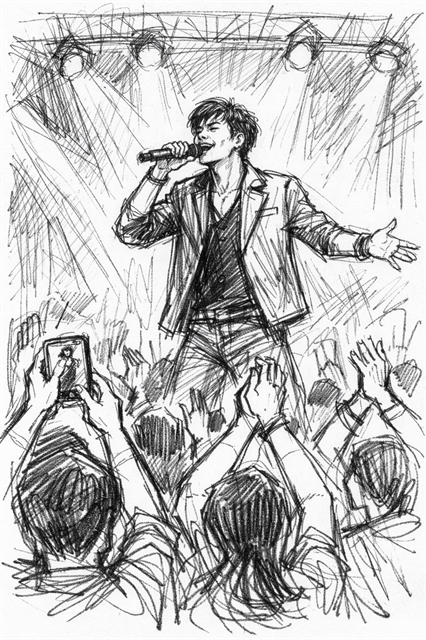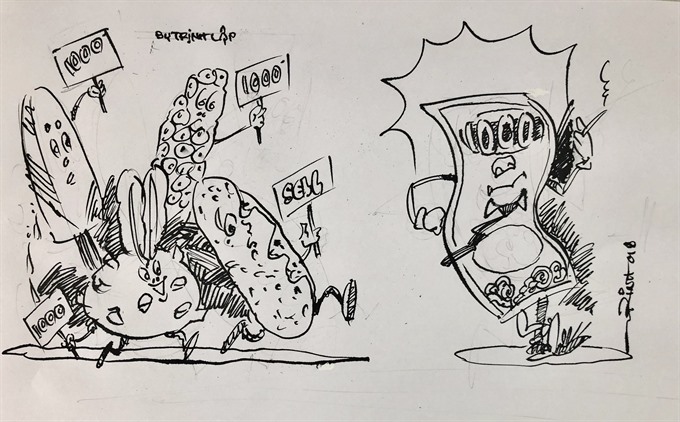 Talk Around Town
Talk Around Town

But in Việt
One thousand Việt
But in Việt
 |
| Illustration by Trịnh Lập |
by Mathilde Tuyết Trần
Looking down at the bunch of small notes I was holding in my hand, the cab driver said, “Please give me those small notes for change. If you give those notes to the street beggars, they wouldn’t take them!”
They were VNĐ1,000 and VNĐ2,000 notes, even a few of the VNĐ500 pinky notes. These are the smallest monetary notes currently in circulation in Việt
I thought to myself that some tourists do not know the buying power of the Vietnamese currency, so they usually waste their money—or can be convinced to hand it over to a cab driver after they’ve already paid their fare.
One thousand Việt
But in Việt
Twenty thousand đồng (less than an euro and a US dollar) can be a vital portion of a worker’s wage: With VNĐ20,000, one can have a big bowl of rice and a large garlic roasted rib, whose fragrance will tempt your empty stomach.
Ten thousand đồng (less than half an euro or a dollar) can buy you a loaf of bread with eggs or meat, a bowl of instant noodles with some meat, slices of roast pork paste or a bun of sticky rice, a popular breakfast bundle often sold at humble sidewalk posts.
In the morning, you can see breakfast carts on the streets selling steamed broken rice, noodle, phở noodle soup and bún vermicelli, rice porridge and sticky rice. People gather around the seller enjoying their meals before going to work or to school.
In the late afternoon, the street food scene grows even bigger and more exciting. There are so many of them, each cart has its own special snack. Bò bía rolls with julienned coconut in rice paper, roasted escargots of all size and shapes and flavours, roasted rice cakes, dry squid on charcoal, baby duck eggs, roasted chicken eggs, meat buns, sticky rice and chicken porridge—all are sold for less than VNĐ10,000 a portion for students and schoolchildren.
People living in Hồ Chí Minh City know where to go to have good food at reasonable price. It seems to me, a visitor to the city, that people eat all day long. Especially at night, when it’s cooler, people tend to gather around a dining table chatting and drinking.
Street food is as much a social experience – and a much more ubiquitous one – as the more relaxed meals eaten at higher-end restaurants.
Tourists like me always have to pay double or three times more street food favourites when we eat them in more established venues like Phở Hòa Pasteur or any of the Ngon restaurants or the dining quarter at the Bến Thành Market. We pay VNĐ75,000 for a bowl of soup, or VNĐ90,000 in four-star city hotels. Honestly, the food does not taste better, only the bill is higher.
But what’s more important to tourists, beyond the food itself, are food safety and hygiene, the cleanliness of the table and chairs and service. That’s why some not-so-good restaurants serving not the greatest food are more frequented by tourists. Tourists are used to having food on chairs and table. They are quite surprised to see local people having food on plastic or wooden stools, which are as small as kindergarten stools. They are afraid of falling off the seats and are not used to eating with their stomachs compressed as they bend towards their bowl on the table.
If you go to the market, you can see all kinds of fruits and vegetables, meats and poultry and seafood at very low prices compared to the same merchandise in
Since I realised the purchasing power of the one-thousand and two-thousand đồng notes, I stopped ignoring them and started to be more careful with my spending.
Do you know what one or two thousand đồng can buy at this time?
You can buy some pieces of paper to write a letter or a proposal, an envelope, a stamp, rubber bands, make a photocopy, a plastic container for food storage, a Styrofoam box, a plastic bag, a shampoo or shower gel sachet or a piece of soap.
You can buy a bag of white rice, an instant noodle pack, a bundle of fresh noodles, a loaf of bread, some chilis, a lemon or some kumquats, some green onions, coriander, bean sprouts, a bundle of vegetables, sea salts, some sesame, one sweet potato, one banana, some tumeric roots or ginger, a garlic, a maize cob, a tomato, an onion, or a piece of tofu.
In a public restroom near a park, I saw one- and two-thousand đồng notes neatly placed in a plastic box next to a pack of toilet paper. Put a note in, and you can take away the paper for your use.
I have gone a long way to say, “Do not look down on those small notes of one- and two-thousand đồng, that ’even a beggar would not take’!”
Above the two-thousand notes is the five-thousand đồng note. Cab drivers tend to round the amount tourists have to pay for their ride, for example, if the ride is VNĐ74,000, and you give them a 100-thousand note, they will just give you VNĐ20,000 back to avoid producing the small change.
Higher up in the range of notes, a ten-thousand đồng note can buy a lottery ticket that can be quite meaningful for a normal worker. It’s psychologically proven, that the poorer one becomes, the more one wants to win a lottery ticket. So they end up exchanging their hard-earned money for the glimmer of hope attached to the ticket.
A few years back, a publisher in HCM City wanted to publish one of my books. But I disagreed with the editor, who wanted to cut a part of the book explaining the price index in the markets in Việt
The market price fluctuations can lead to effective economic decisions or policies.
If the editor cut that part out, my book would not carry the intention of the writer.
I changed my mind and decided not to publish the book. As any shopper strolling through HCM City can tell you, price matters—and so do small đồng notes. VNS




